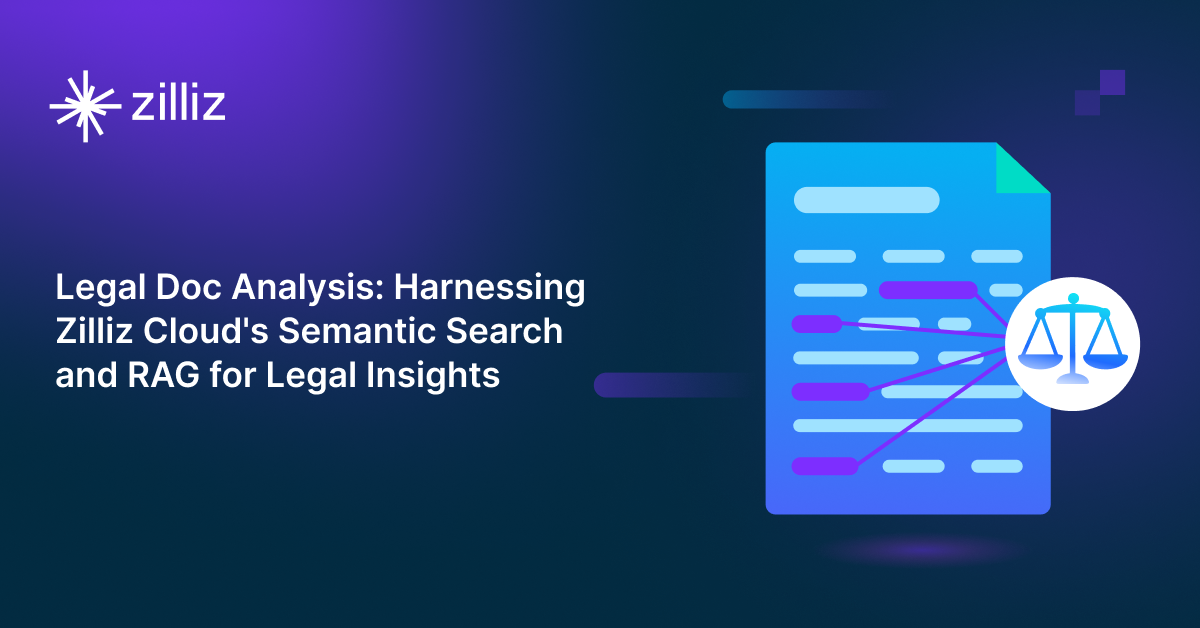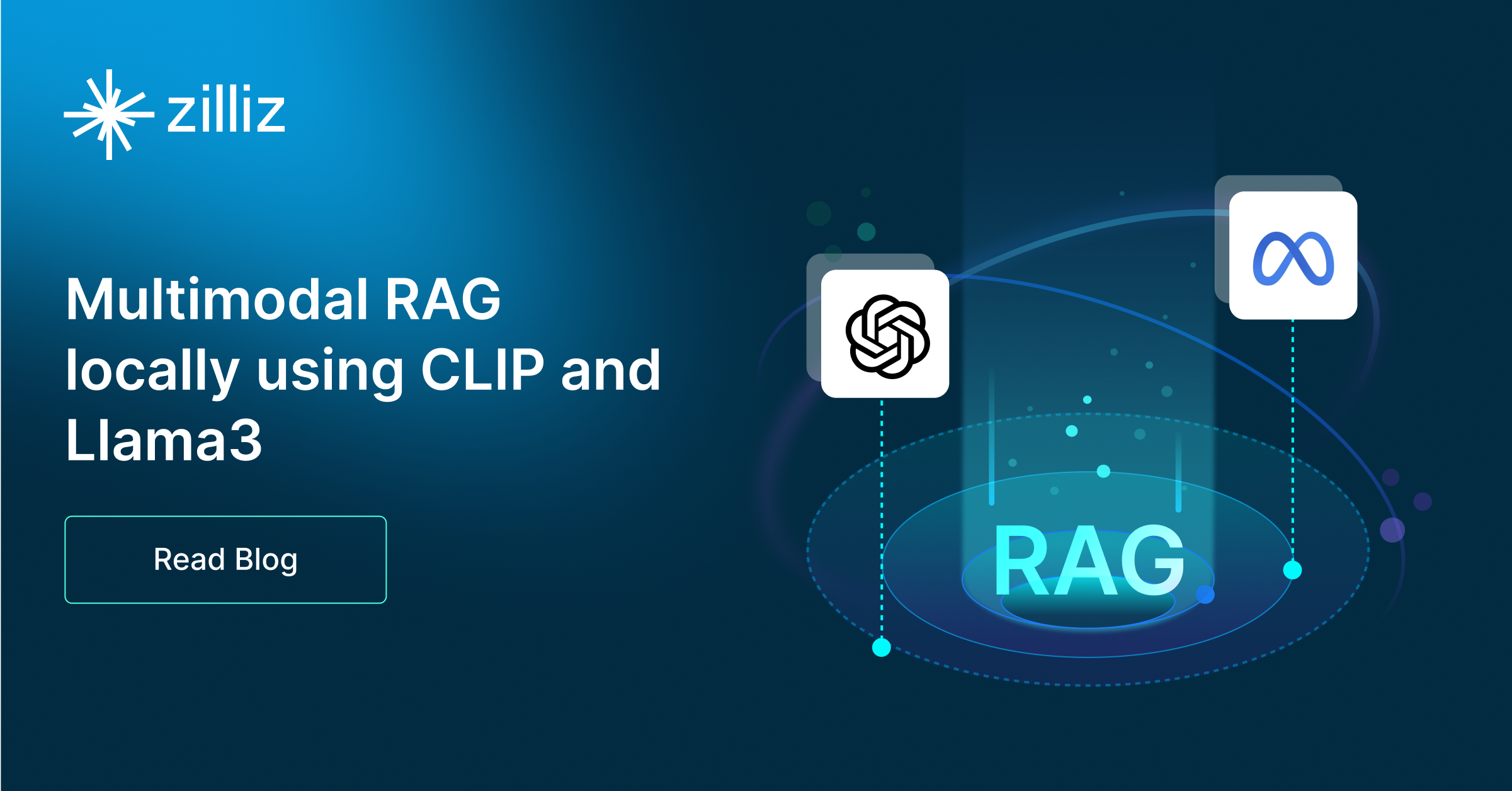Build RAG Chatbot with Haystack, Milvus, NVIDIA Llama 3 70B Instruct, and Cohere embed-english-v2.0
Introduction to RAG
Retrieval-Augmented Generation (RAG) is a game-changer for GenAI applications, especially in conversational AI. It combines the power of pre-trained large language models (LLMs) like OpenAI’s GPT with external knowledge sources stored in vector databases such as Milvus and Zilliz Cloud, allowing for more accurate, contextually relevant, and up-to-date response generation. A RAG pipeline usually consists of four basic components: a vector database, an embedding model, an LLM, and a framework.
Key Components We'll Use for This RAG Chatbot
This tutorial shows you how to build a simple RAG chatbot in Python using the following components:
- Haystack: An open-source Python framework designed for building production-ready NLP applications, particularly question answering and semantic search systems. Haystack excels at retrieving information from large document collections through its modular architecture that combines retrieval and reader components. Ideal for developers creating search applications, chatbots, and knowledge management systems that require efficient document processing and accurate information extraction from unstructured text.
- Milvus: An open-source vector database optimized to store, index, and search large-scale vector embeddings efficiently, perfect for use cases like RAG, semantic search, and recommender systems. If you hate to manage your own infrastructure, we recommend using Zilliz Cloud, which is a fully managed vector database service built on Milvus and offers a free tier supporting up to 1 million vectors.
- NVIDIA Llama 3 70B Instruct: A high-performance AI model optimized by NVIDIA for complex instruction-following tasks, combining Meta's Llama 3 70B architecture with NVIDIA’s hardware-accelerated efficiency. Strengths include rapid inference, scalability on GPUs, and nuanced context understanding. Ideal for enterprise-grade chatbots, technical support automation, and data-driven decision-making in resource-intensive environments.
- Cohere embed-english-v2.0: A powerful text embedding model designed to convert English text into high-dimensional vector representations. It excels at capturing semantic relationships, enabling tasks like semantic search, clustering, and text classification. Optimized for accuracy and scalability, it is ideal for applications requiring robust natural language understanding, such as recommendation systems, document retrieval, and retrieval-augmented generation (RAG) pipelines.
By the end of this tutorial, you’ll have a functional chatbot capable of answering questions based on a custom knowledge base.
Note: Since we may use proprietary models in our tutorials, make sure you have the required API key beforehand.
Step 1: Install and Set Up Haystack
import os
import requests
from haystack import Pipeline
from haystack.components.converters import MarkdownToDocument
from haystack.components.preprocessors import DocumentSplitter
from haystack.components.writers import DocumentWriter
Step 2: Install and Set Up NVIDIA Llama 3 70B Instruct
To start using models self-hosted with NVIDIA, we need to install the nvidia-haystack package first.
pip install nvidia-haystack
To use LLMs with NVIDIA, you need to specify the correct api_url and your API key. You can get your API key directly from the catalog website. You also need to get an NVIDIA API key to build this pipeline. Here, we will use the NVIDIA_API_KEY environment variable by default. Otherwise, you can pass an API key at initialization with api_key, as in the following example.
from haystack.utils.auth import Secret
from haystack_integrations.components.generators.nvidia import NvidiaGenerator
generator = NvidiaGenerator(
model="meta/llama3-70b-instruct",
api_url="https://integrate.api.nvidia.com/v1",
api_key=Secret.from_token("<your-api-key>"),
model_arguments={
"temperature": 0.2,
"top_p": 0.7,
"max_tokens": 1024,
},
)
generator.warm_up()
Step 3: Install and Set Up Cohere embed-english-v2.0
To start using this integration with Haystack, install it with:
pip install cohere-haystack
from haystack import Document
from haystack_integrations.components.embedders.cohere.document_embedder import CohereDocumentEmbedder
from haystack_integrations.components.embedders.cohere.text_embedder import CohereTextEmbedder
text_embedder = CohereTextEmbedder(model="embed-english-v2.0")
document_embedder = CohereDocumentEmbedder(model="embed-english-v2.0")
Step 4: Install and Set Up Milvus
pip install --upgrade pymilvus milvus-haystack
from milvus_haystack import MilvusDocumentStore
from milvus_haystack.milvus_embedding_retriever import MilvusEmbeddingRetriever
document_store = MilvusDocumentStore(connection_args={"uri": "./milvus.db"}, drop_old=True,)
retriever = MilvusEmbeddingRetriever(document_store=document_store, top_k=3)
Step 5: Build a RAG Chatbot
Now that you’ve set up all components, let’s start to build a simple chatbot. We’ll use the Milvus introduction doc as a private knowledge base. You can replace it your own dataset to customize your RAG chatbot.
url = 'https://raw.githubusercontent.com/milvus-io/milvus-docs/refs/heads/v2.5.x/site/en/about/overview.md'
example_file = 'example_file.md'
response = requests.get(url)
with open(example_file, 'wb') as f:
f.write(response.content)
file_paths = [example_file] # You can replace it with your own file paths.
indexing_pipeline = Pipeline()
indexing_pipeline.add_component("converter", MarkdownToDocument())
indexing_pipeline.add_component("splitter", DocumentSplitter(split_by="sentence", split_length=2))
indexing_pipeline.add_component("embedder", document_embedder)
indexing_pipeline.add_component("writer", DocumentWriter(document_store))
indexing_pipeline.connect("converter", "splitter")
indexing_pipeline.connect("splitter", "embedder")
indexing_pipeline.connect("embedder", "writer")
indexing_pipeline.run({"converter": {"sources": file_paths}})
# print("Number of documents:", document_store.count_documents())
question = "What is Milvus?" # You can replace it with your own question.
retrieval_pipeline = Pipeline()
retrieval_pipeline.add_component("embedder", text_embedder)
retrieval_pipeline.add_component("retriever", retriever)
retrieval_pipeline.connect("embedder", "retriever")
retrieval_results = retrieval_pipeline.run({"embedder": {"text": question}})
# for doc in retrieval_results["retriever"]["documents"]:
# print(doc.content)
# print("-" * 10)
from haystack.utils import Secret
from haystack.components.builders import PromptBuilder
retriever = MilvusEmbeddingRetriever(document_store=document_store, top_k=3)
text_embedder = CohereTextEmbedder(model="embed-english-v2.0")
prompt_template = """Answer the following query based on the provided context. If the context does
not include an answer, reply with 'I don't know'.\n
Query: {{query}}
Documents:
{% for doc in documents %}
{{ doc.content }}
{% endfor %}
Answer:
"""
rag_pipeline = Pipeline()
rag_pipeline.add_component("text_embedder", text_embedder)
rag_pipeline.add_component("retriever", retriever)
rag_pipeline.add_component("prompt_builder", PromptBuilder(template=prompt_template))
rag_pipeline.add_component("generator", generator)
rag_pipeline.connect("text_embedder.embedding", "retriever.query_embedding")
rag_pipeline.connect("retriever.documents", "prompt_builder.documents")
rag_pipeline.connect("prompt_builder", "generator")
results = rag_pipeline.run({"text_embedder": {"text": question}, "prompt_builder": {"query": question},})
print('RAG answer:\n', results["generator"]["replies"][0])
Optimization Tips
As you build your RAG system, optimization is key to ensuring peak performance and efficiency. While setting up the components is an essential first step, fine-tuning each one will help you create a solution that works even better and scales seamlessly. In this section, we’ll share some practical tips for optimizing all these components, giving you the edge to build smarter, faster, and more responsive RAG applications.
Haystack optimization tips
To optimize Haystack in a RAG setup, ensure you use an efficient retriever like FAISS or Milvus for scalable and fast similarity searches. Fine-tune your document store settings, such as indexing strategies and storage backends, to balance speed and accuracy. Use batch processing for embedding generation to reduce latency and optimize API calls. Leverage Haystack's pipeline caching to avoid redundant computations, especially for frequently queried documents. Tune your reader model by selecting a lightweight yet accurate transformer-based model like DistilBERT to speed up response times. Implement query rewriting or filtering techniques to enhance retrieval quality, ensuring the most relevant documents are retrieved for generation. Finally, monitor system performance with Haystack’s built-in evaluation tools to iteratively refine your setup based on real-world query performance.
Milvus optimization tips
Milvus serves as a highly efficient vector database, critical for retrieval tasks in a RAG system. To optimize its performance, ensure that indexes are properly built to balance speed and accuracy; consider utilizing HNSW (Hierarchical Navigable Small World) for efficient nearest neighbor search where response time is crucial. Partitioning data based on usage patterns can enhance query performance and reduce load times, enabling better scalability. Regularly monitor and adjust cache settings based on query frequency to avoid latency during data retrieval. Employ batch processing for vector insertions, which can minimize database lock contention and enhance overall throughput. Additionally, fine-tune the model parameters by experimenting with the dimensionality of the vectors; higher dimensions can improve retrieval accuracy but may increase search time, necessitating a balance tailored to your specific use case and hardware infrastructure.
NVIDIA Llama 3 70B Instruct optimization tips
Optimize inference speed by leveraging model quantization (e.g., 16-bit or 8-bit) to reduce memory usage without significant accuracy loss. Use NVIDIA’s TensorRT-LLM for kernel fusion and efficient GPU utilization, and enable dynamic batching to process multiple queries concurrently. Fine-tune retrieval relevance thresholds to balance precision and recall, minimizing unnecessary context. Cache frequent retrieval results and precompute embeddings. Profile memory usage to avoid bottlenecks, and employ mixed-precision training if fine-tuning. Regularly update drivers and libraries (e.g., CUDA, PyTorch) to leverage hardware acceleration and software optimizations.
Cohere embed-english-v3.0 optimization tips
To optimize Cohere embed-english-v3.0 in RAG, ensure input text is clean and concise—remove redundant whitespace, special characters, or irrelevant content. Use shorter chunks (e.g., 256-512 tokens) aligned with semantic boundaries to improve relevance. Batch embedding requests for efficiency. Fine-tune truncation settings to retain critical context. Pair with a low-latency vector database (e.g., FAISS or HNSW) and pre-filter noisy data. Monitor embedding quality via retrieval accuracy metrics (e.g., recall@k) and adjust chunking or preprocessing as needed. Leverage Cohere’s input_type parameter (search_document/search_query) for task-aware embeddings.
By implementing these tips across your components, you'll be able to enhance the performance and functionality of your RAG system, ensuring it’s optimized for both speed and accuracy. Keep testing, iterating, and refining your setup to stay ahead in the ever-evolving world of AI development.
RAG Cost Calculator: A Free Tool to Calculate Your Cost in Seconds
Estimating the cost of a Retrieval-Augmented Generation (RAG) pipeline involves analyzing expenses across vector storage, compute resources, and API usage. Key cost drivers include vector database queries, embedding generation, and LLM inference.
RAG Cost Calculator is a free tool that quickly estimates the cost of building a RAG pipeline, including chunking, embedding, vector storage/search, and LLM generation. It also helps you identify cost-saving opportunities and achieve up to 10x cost reduction on vector databases with the serverless option.
 Calculate your RAG cost
Calculate your RAG cost
What Have You Learned?
By diving into this tutorial, you’ve unlocked the power of combining cutting-edge tools to build your own RAG system from scratch! You learned how Haystack acts as the backbone of your pipeline, seamlessly connecting components to orchestrate workflows. With Milvus as your vector database, you discovered how to store and retrieve embeddings at lightning speed, turning unstructured data into a searchable treasure trove. The Cohere embed-english-v2.0 model became your magic wand for transforming text into rich, meaningful vectors, ensuring your system understands context and nuance. And when it came time to generate answers, NVIDIA’s Llama 3 70B Instruct stepped in as your conversational genius, leveraging its massive knowledge base to craft human-like responses. Together, these tools form a dynamic quartet that handles everything from data ingestion to intelligent output—proving that RAG isn’t just a concept but a tangible, powerful solution you can build and customize.
But you didn’t stop there! The tutorial also armed you with pro tips for optimizing performance, like tweaking chunk sizes and balancing speed with accuracy, plus a free RAG cost calculator to keep your projects budget-friendly. Now that you’ve seen how these pieces fit together—and how they scale from prototypes to production—you’re ready to innovate. Imagine the applications: smarter chatbots, hyper-personalized search tools, or even AI-powered research assistants. The tools are in your hands, the foundation is laid, and the possibilities are endless. So go ahead—experiment, iterate, and let your creativity run wild. The future of intelligent systems starts with you building it. Time to make your mark! 🚀
Further Resources
🌟 In addition to this RAG tutorial, unleash your full potential with these incredible resources to level up your RAG skills.
- How to Build a Multimodal RAG | Documentation
- How to Enhance the Performance of Your RAG Pipeline
- Graph RAG with Milvus | Documentation
- How to Evaluate RAG Applications - Zilliz Learn
- Generative AI Resource Hub | Zilliz
We'd Love to Hear What You Think!
We’d love to hear your thoughts! 🌟 Leave your questions or comments below or join our vibrant Milvus Discord community to share your experiences, ask questions, or connect with thousands of AI enthusiasts. Your journey matters to us!
If you like this tutorial, show your support by giving our Milvus GitHub repo a star ⭐—it means the world to us and inspires us to keep creating! 💖
- Introduction to RAG
- Key Components We'll Use for This RAG Chatbot
- Step 1: Install and Set Up Haystack
- Step 2: Install and Set Up NVIDIA Llama 3 70B Instruct
- Step 3: Install and Set Up Cohere embed-english-v2.0
- Step 4: Install and Set Up Milvus
- Step 5: Build a RAG Chatbot
- Optimization Tips
- RAG Cost Calculator: A Free Tool to Calculate Your Cost in Seconds
- What Have You Learned?
- Further Resources
- We'd Love to Hear What You Think!
Content
Vector Database at Scale
Zilliz Cloud is a fully-managed vector database built for scale, perfect for your RAG apps.
Try Zilliz Cloud for Free


